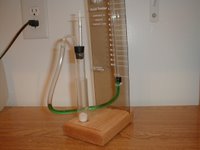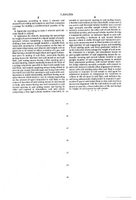
This post is an attempt to evaluate the use of the Purple Foot Direct reading Acid tester for an inexpensive, quick, easy, and hopefully accurate alternative for measuring the TA (total acidity/titratable acidity) in a wine/juice sample. The performance will be compared with that of determining TA via Titration.
Since I am having formatting problems in blogger, for a more detailed treatment of this, please go to
http://www.toastorpie.com/ta_tester/ta_tester.html
The Direct Reading Acid Tester combines a known volume of wine with Baking Soda (sodium bicarbonate) and measures the volume of CO2 evolved by the reaction. The volume of CO2 evolved can then be related to the amount of acid in the sample. As of writing this, the device was available for purchase for under $40(US dollars) (without shipping) from the Purple Foot in Milwaukee, WI. The device is also simple enough, that one could build the device for much less. However, the Purple Foot device is well constructed and very reasonably priced (note: they are made "on demand", so there may be some delay in getting one.) The only chemicals needed are tap water for measuring the gas volume, and Baking soda for the reaction (I used Arm and Hammer which is less than $1.00 US dollars per box.)
Disclaimer ... I am not a chemist nor wine acid expert, just an amature wine maker striving to improve his wine making skills (and trying to remember his chemistry and physics from 15 years ago!)
For details tables, graphs, data etc. see http://www.toastorpie.com/ta_tester/ta_tester.htmlConclusions:
The Purple Foot direct reading "acid tester" is, extremely easy to use, set up, clean up after, and inexpensive to purchase and operate. It does not use poisonous chemicals which can go out of date and can significantly affect TA accuracy. It is relatively free of processes where the operator can introduce measurement errors and it only requires a very small juice/wine sample. When no leaks occur and the instrument is calibrated, it is fairly accurate (at least in the range measured .4 -1.0 TA in g/100ml.)
However, several errors, primarily due to leaks and stopper movement, can give large variability in readings. Repeated use may cause these problems to occur more frequently. The issue has been raised that the device may be sensitive to the elevation (air pressure) at the location it is used, therefore, the device needs to be calibrated for the location (elevation) where it is used. This calibration can be quite time consuming.
I would/will use the Purple foot acid tester as a quick indication of TA in the vineyard to assess ripeness, and occasionally during the wine making process (especially with non grape wines.) In general, unless the significant sources of errors can be mitigated ... primarily leaks and stopper movement, I would still use titration when more accurate results are required.
 This post is an attempt to evaluate the use of the Purple Foot Direct reading Acid tester for an inexpensive, quick, easy, and hopefully accurate alternative for measuring the TA (total acidity/titratable acidity) in a wine/juice sample. The performance will be compared with that of determining TA via Titration.
Since I am having formatting problems in blogger, for a more detailed treatment of this, please go to http://www.toastorpie.com/ta_tester/ta_tester.html
The Direct Reading Acid Tester combines a known volume of wine with Baking Soda (sodium bicarbonate) and measures the volume of CO2 evolved by the reaction. The volume of CO2 evolved can then be related to the amount of acid in the sample. As of writing this, the device was available for purchase for under $40(US dollars) (without shipping) from the Purple Foot in Milwaukee, WI. The device is also simple enough, that one could build the device for much less. However, the Purple Foot device is well constructed and very reasonably priced (note: they are made "on demand", so there may be some delay in getting one.) The only chemicals needed are tap water for measuring the gas volume, and Baking soda for the reaction (I used Arm and Hammer which is less than $1.00 US dollars per box.)
Disclaimer ... I am not a chemist nor wine acid expert, just an amature wine maker striving to improve his wine making skills (and trying to remember his chemistry and physics from 15 years ago!)
For details tables, graphs, data etc. see http://www.toastorpie.com/ta_tester/ta_tester.html
This post is an attempt to evaluate the use of the Purple Foot Direct reading Acid tester for an inexpensive, quick, easy, and hopefully accurate alternative for measuring the TA (total acidity/titratable acidity) in a wine/juice sample. The performance will be compared with that of determining TA via Titration.
Since I am having formatting problems in blogger, for a more detailed treatment of this, please go to http://www.toastorpie.com/ta_tester/ta_tester.html
The Direct Reading Acid Tester combines a known volume of wine with Baking Soda (sodium bicarbonate) and measures the volume of CO2 evolved by the reaction. The volume of CO2 evolved can then be related to the amount of acid in the sample. As of writing this, the device was available for purchase for under $40(US dollars) (without shipping) from the Purple Foot in Milwaukee, WI. The device is also simple enough, that one could build the device for much less. However, the Purple Foot device is well constructed and very reasonably priced (note: they are made "on demand", so there may be some delay in getting one.) The only chemicals needed are tap water for measuring the gas volume, and Baking soda for the reaction (I used Arm and Hammer which is less than $1.00 US dollars per box.)
Disclaimer ... I am not a chemist nor wine acid expert, just an amature wine maker striving to improve his wine making skills (and trying to remember his chemistry and physics from 15 years ago!)
For details tables, graphs, data etc. see http://www.toastorpie.com/ta_tester/ta_tester.html





